Salvia is a genus of plant that encompasses almost 1,000 species of shrubs, perennials, and annuals. They are actually the largest genus in the mint family, Lamiaceae. The scientific name for sage, the popular kitchen herb, is Salvia officinalis. While not all varieties can be used to flavor your meals, most of them can be colorful, perennial additions to your garden.
Most species are incredibly easy to care for. In addition, the wide selection of varieties to choose from allows you to choose a plant based on the condition of your gardens.
If you have a Chinese elm tree, make sure to also check our guide on how to take care of one.
Do you have full sun and well-drained soil? Salvia coccinea may work for you. How about partial shade and moist, boggy soil? Try planting some Salvia uliginosa!
A border of perennial salvia is a common sight in the garden. With their heights ranging from 12 inches to 5 or more feet tall, there is a variety that will fit well in any situation.
Growing them is simple, especially when you use the techniques and care recommendations that we have provided below.
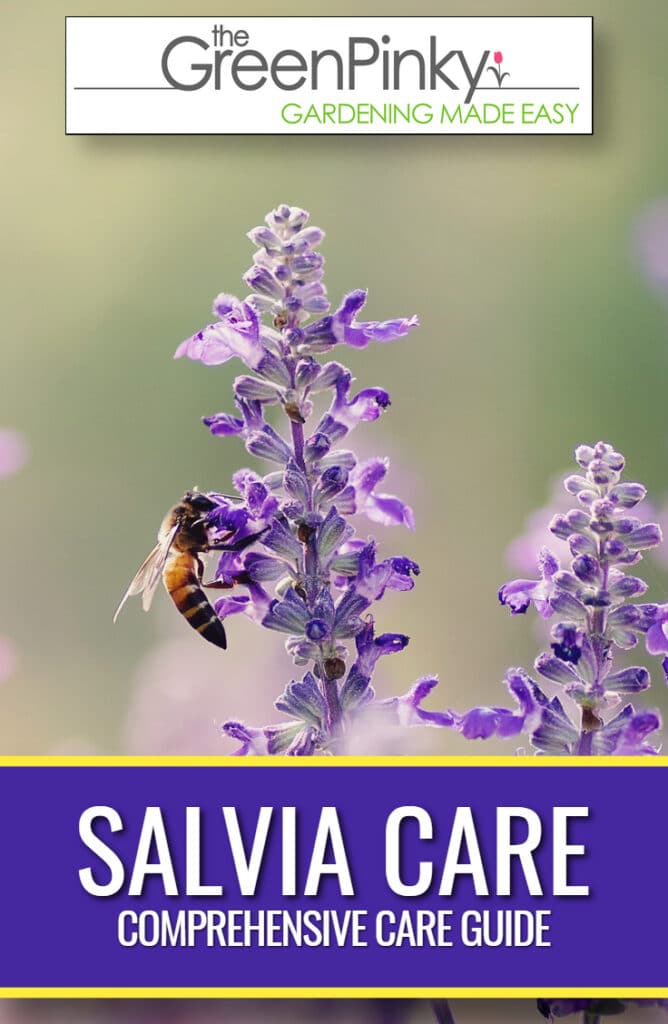
General Care Guide
The care regimen for salvias is relatively simple. Adequate sun, water, and well-drained, fertile soil are all that most varieties require to thrive. Many species will perform well as perennials in USDA Hardiness Zones 5 through 9. Some varieties will survive the winters in zone 4, while others can withstand the heat of summer in zone 10.
For most species, the bloom time is from late spring to fall. Most salvia species are also referred to as “bush sage” because of their tendency to take the shape of small bushes.
Amount of Sun
Most varieties enjoy full sun exposure, with about 6 hours of direct sunlight required to trigger flowering in the plants. There are some varieties, such as Salvia patens or roemeriana that will tolerate partial or full shade.
Watering Frequency
Salvias enjoy well-drained soil. They do not require excessive water during the summer growing season. As long as they are receiving at least 1 inch of rain per week, they should be happy. In addition, adding a 2 to 3-inch layer of mulch around the base will aid in moisture retention and weed prevention. They are drought-tolerant and can handle adverse watering and garden soil conditions.
Fertilization
In early spring, apply a layer of compost or fertilizer around the base of each plant. Lightly rake the compost into the soil and apply a 2 to 3-inch layer of mulch. Your salvias should not require another round of fertilization until next spring.
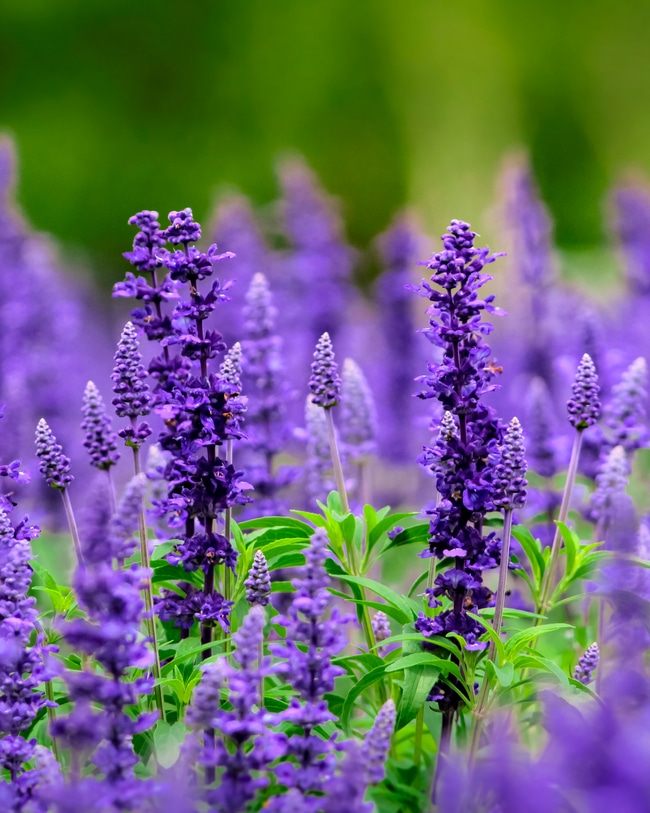
Pruning
Most varieties of salvia die off and go dormant for the winter, although this will depend on the USDA Hardiness Zone and the type of salvia being grown.
If your salvias go dormant, then pruning is hardly necessary. If you wish, you may prune the dead stalks as you please during the fall and use them as mulch. Any stalks that produce seed can germinated into new plants in the spring.
Many gardeners choose to wait to prune until after the flowers have produced seed and died off. This allows the plants to reseed in the spring and also provides a source of food for your local birds.
Deadheading
“Deadheading” is a popular pruning technique to achieve more flowering.
Salvia plants can be pruned during the flowering season with a technique called “deadheading”. The process involves removing the older, dying flower spikes to promote the new growth of stalks and blooms.
It is usually recommended to deadhead salvias by pinching the stalk off with your fingers. This allows the least amount of stress and damage to the plant, as long as care is taken not to pull or tug on the plant.
If the flower stalk is too strong to break with your fingers, cut flowers with pruning shears, instead. Just be sure to disinfect the shears before use to prevent the spread of diseases among your plants. This is also the method of choice if you have a large number of plants to deadhead.
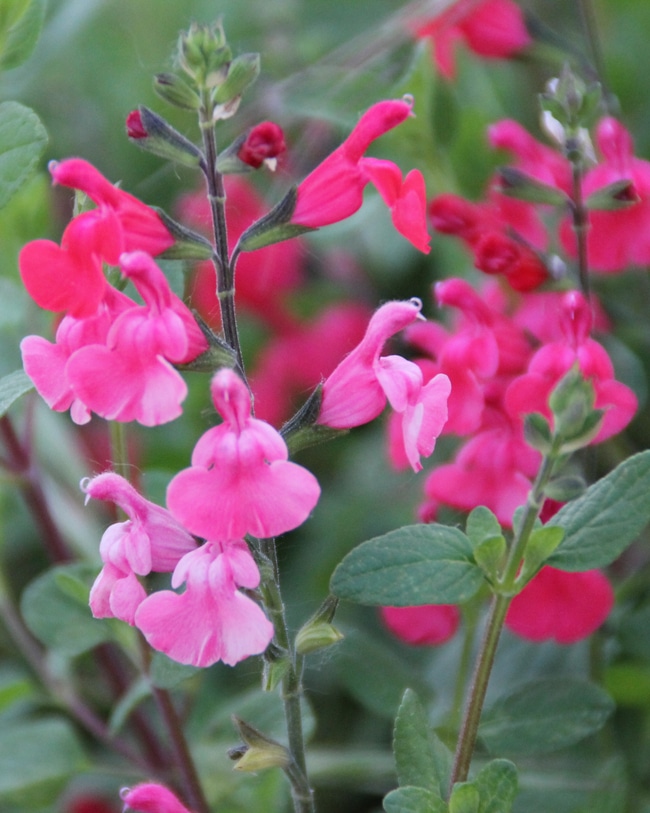
Dividing
Salvias can easily be divided if they are growing too large.
Early in the spring season, before new growth appears, dig up the roots. Divide the root ball into clumps and replant each individual clump. Cover each clump with 1 to inches of soil and a 1 inch layer of compost. Cover with a layer of mulch and water well. Continue watering every time the soil dries out until the plant becomes established. Each planted clump will become its own plant that can then be divided in a few years’ time.
Another interesting idea for your garden is to create a shade garden in areas of your yard where you don’t have full sun exposure.
Popular Types
There are too many varieties to list here, but we will cover a few of the most popular. Flower colors commonly range from bright red to purple to blue. Most varieties will bloom from early spring until the first frost, with the most blooms being present in mid-summer.
- Salvia coccinea, also known as scarlet sage, is known for its vivid red flower color. The plant is common in the Southeastern US and has grown popular in gardens worldwide. S. coccinea performs as a perennial in USDA Zones 9 and 10, as it can thrive in the summer heat. It propagates through reseeding in zones 6 through 8. It can be grown as an annual in colder zones. Scarlet sage can grow to around 3 feet tall and 2 ½ feet wide, performing as a small shrub in the garden.
- Salvia farinacea, also known as mealycup sage, produces blue flowers with the distinctive smell of sage. The flower stalks grow to around 3 feet, while the plant itself can spread around 2 feet wide. S. farinacea grows well as a perennial in zones 8 through 10 and can be grown as an annual in colder climates.
- Salvia elegans, also known as pineapple sage, is native to Mexico and Guatemala and features red flowers. It grows as a perennial in USDA Zones 8 through 10, enjoying full sun and a well-drained soil. However, it is tolerant to adverse conditions, including partial shade and drought. The red plant can be grown as an annual throughout colder climates. S. elegans can grow to 4 feet in height and around 3 feet wide over the course of one growing season.
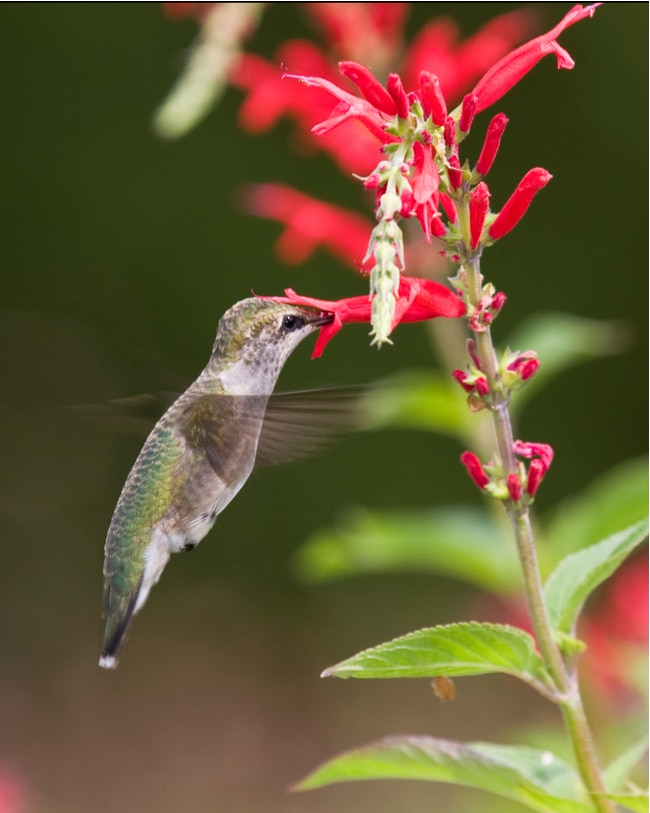
- Salvia nemorosa, also known as the woodland sage, is native to Europe and Asia and features purple and blue flowers. The bush sage is popular with butterflies and hummingbirds, which lends to its use in butterfly and pollinator gardens. S. nemorosa grows in clumps around one foot in height and 1 ½ feet wide. The flower spikes can be cut back as they die off to encourage another round of blooms to take their place.
- “Red Hot Sally” are a popular variety. They bloom into vibrant, red flowers that add a strong contrast to the green foliage. It is early blooming and hardy.
- ‘Blue Hill’ salvia is one of the most popular cultivars (subspecies) of S. nemorosa, known for its bold blue flowers. It is one of the easiest blue-colored varieties to grow, as it is tolerant of adverse conditions like drought. Best of all, it is a vigorous flower producer and will light up your perennial garden with blooms of blue throughout the entire summer.
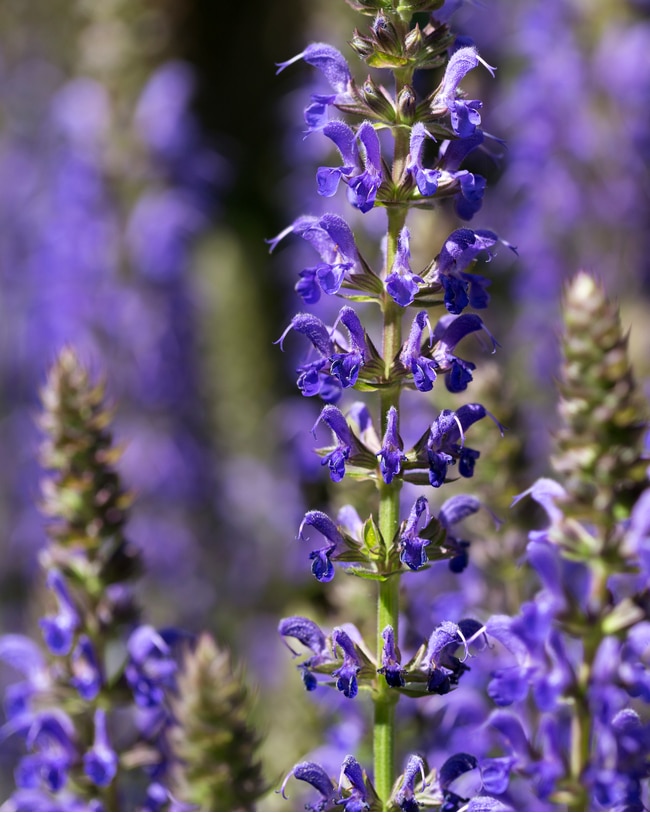
- ‘Violet Profusion’ salvia is another cultivar of S. nemorosa that has been bred to feature deep purple flowers. It otherwise performs the same as other S. nemorosa cultivars.
- Salvia greggii, also known as autumn sage, is a small shrubby plant with flowers that show shades of red, purple, and pink. The blooms of autumn sage are long-lasting and are known to attract hummingbirds.
- ‘Hot Lips’ is a popular cultivar of Salvia microphylla. The bright red flowers of ‘Hot Lips’ last from early summer until the first frost. ‘Hot Lips’ can grow to a height of around three feet tall and will thrive in full sun. The red and pink flowers will last until early fall.
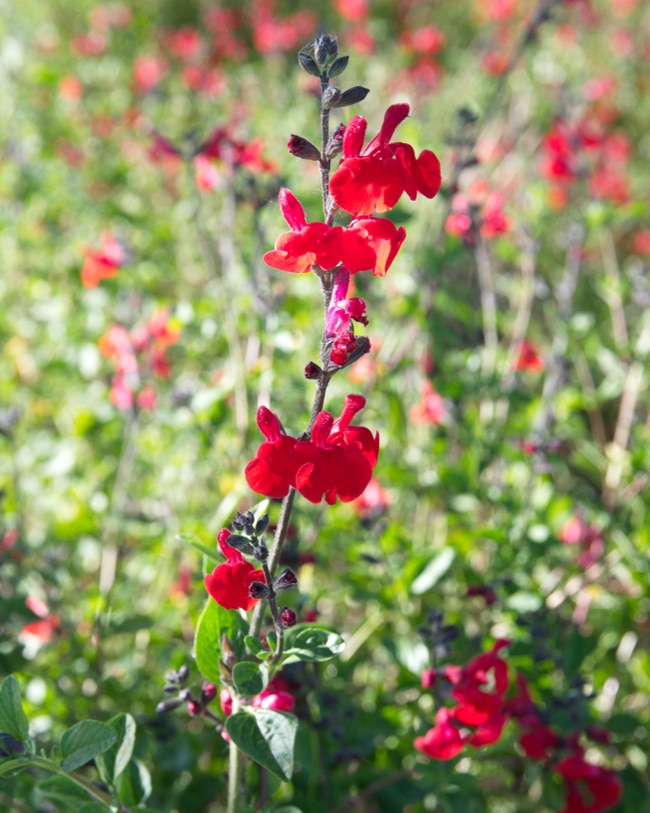
Design Ideas
Perennial salvias are great plants to use in garden design. They provide a short and colorful border for the rest of your perennial garden.
Most varieties grow from one to three feet tall, providing a low border of beautiful blooms. Planting a variety of species can provide a nice mix of colors. For instance, ‘Hot Lips’, ‘Violet Profusion’, and ‘Blue Hill’ could be planted in succession to create a pleasing array of color.
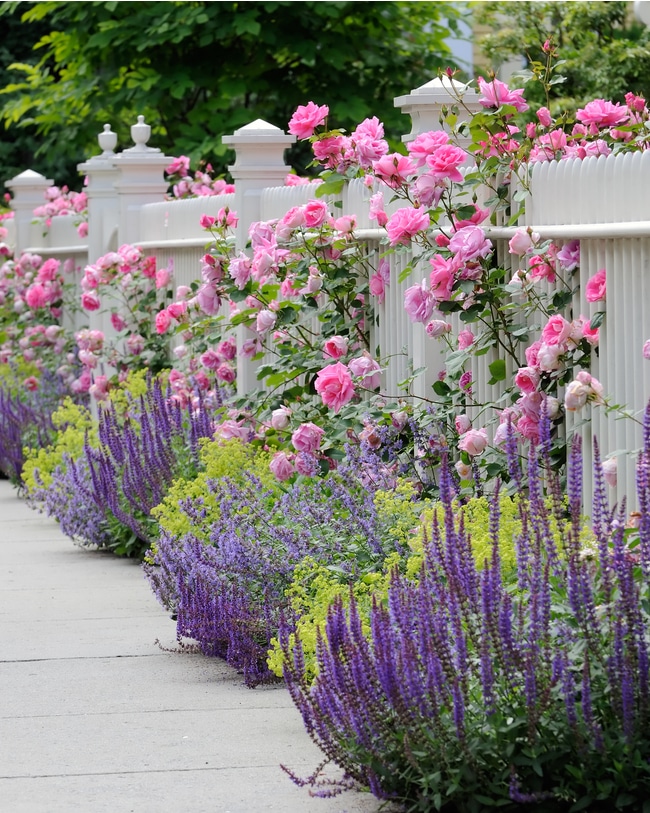
Siberian irises can be planted directly behind the salvias, as the iris flower stalks will protrude above the row of salvia plants. Most irises grow to around 3 or 4 feet tall. Siberian irises are available in various colors, which can be used to create a rainbow of flowers during bloom time.
Oriental lilies would be a great plant to use in the back of your garden design, as the plants can grow to around 6 feet tall. They will provide beautiful blooms in the late summer or early fall, contrasting the early summer blooms of the siberian irises.

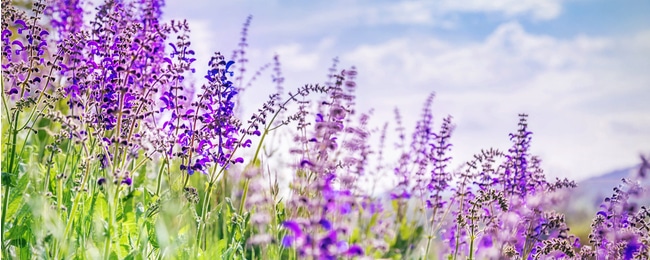
just developing my “green pinky” (so cute!). Happy i found you. Very well written and informative site, i will be back soon!